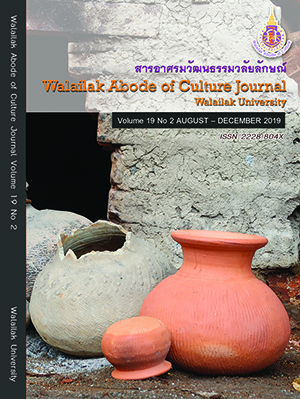Conservation and development of Traditional wicker handicrafts by product design concept
Main Article Content
Abstract
The article presents the development guideline for wicker handicraft products to suit the present. By searching for information that related; the meaning of folk arts and crafts, characteristics and values, the concept of developing from the relevant experts, the current consumer trends and the handicrafts products that presented during the last five years are from 2012 to 2017. To analyze, identify, compare relationships and present them as a guideline for the development of wicker handicraft products. It was found that the variety of target groups and media made possible to present the development of wicker handicraft products in various image as follows: 1) Presentation on the conservation of handicraft and wickerwork 2) Presentation on the continuation of handicraft artwork. 3) Presentation of products that apply handicraft wisdom into new products. 4) Presentation of products that compiled idea and redesign
Article Details
© 2018 by Asian Journal of Arts and Culture, Walailak University. All rights reserved.
References
Chananiyom, A. (2015, November 15). kankamnot konlayut kan okbaep (Designing strategy Determination). Retrieved from http:www.thaicreative.net
Leesuwan, V. (1989). khruang chaksan nai prathet thai (Wicker in Thailand). Bangkok, Thailand: O.S Printing House.
Leesuwan, V. (1989). sinlapa hatthakam thai (Thai Art and Craft). Bangkok Thailand: Tourism Authority of Thailand.
Phrathampitok (Po. O. Payutto). (1994). suepsan watthanatham bon than haeng kansuksa thi thae (Continue Thai Culture on The Basis of Education) (2nd ed.). Bangkok Thailand: Buddhism Foundation.
Phrip Phan Dao พริบพันดาว. (2017). Mong phap hatthakam anakhot then ngan femur asian มองภาพหัตถกรรมอนาคตเทรนด์งานฝีมืออาเซียน (Looking Forward to ASEAN Handicrafts’s Future Trend). Retrieved from : https://www.posttoday.com/life/life/490750
Pinta, A. & Kengphon, A. (2003). kan prapprung sinkha doi kan prayuk chai theknik kan plaeng nathi thang khunnaphap (QDF): korani suksa rongngan phalit khonglen mai phua kansuksa (The Improvement of Product by Using Quality Function Deployment (QDF) Technique: A Case Study of an Educational Wood Toy Factory. The Journal of King Mongkut’s University of Technology North Bangkok, 13(4), 36-42. Retrieved from https://www.thaiscience.info/Journals/Article/ TJKM/10470199.pdf
Ratkasikon, S. & Hincharanan, N. (2008). Laksana thai lem thi si “watthanatham phunban” (Thai Manner volumn 4 “Folk Culture”). Bangkok, Thailand: Amarin Printing & Publishing Public.
Salanukrom Thai samrap yaowachon doi phra bat somdet phrachaoyuhua lem thi yisipsong (Thai Journal Encyclopedia Project by Royal Command of H.M. the King Volumn 22). Retrieved from https://kanchanapisek.or.th/kp6/sub/book/book.php?book=22&chap= 3&page=t22-3-infodetail08.html
Tanner, A. (2010). BATCH craft design product. London, England: A&C Black.
Thailand Creative & Design Center (TCDC). (2018). Cho then lok 2018 (IN-TO the Future: Individual and together with the new state of mind). Retrieved from https://web.tcdc.or.th/media/ publication_lang_file/166/TREND2018-eBook-PC-SinglePage.pdf
Tung, F.W. (2012). Weaving with rush: Exploring craft design collaborations in revitalizing a local craft. International Journal if Design, 6(3), 71-84. Retrieved from https://www.ijdesign.org/ojs/index.php/IJDesign/article/view/1077
Vitsoe. (n.d.). The power of good design Dieter Rams’s ideology, engrained within Vitsoe. Retrieved
from https://www.vitsoe.com/gb/about/good-design


